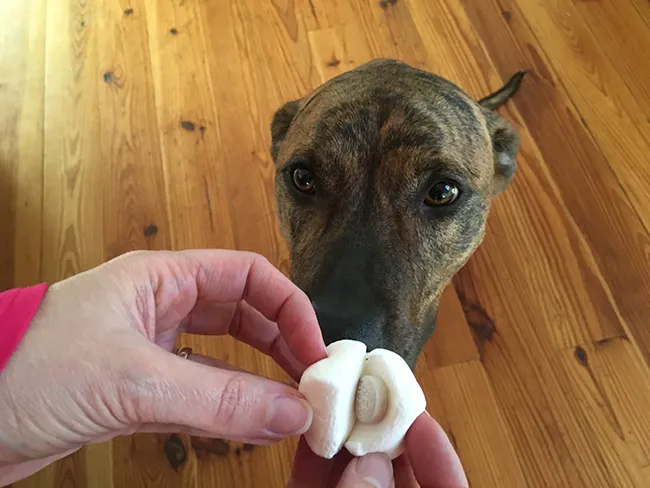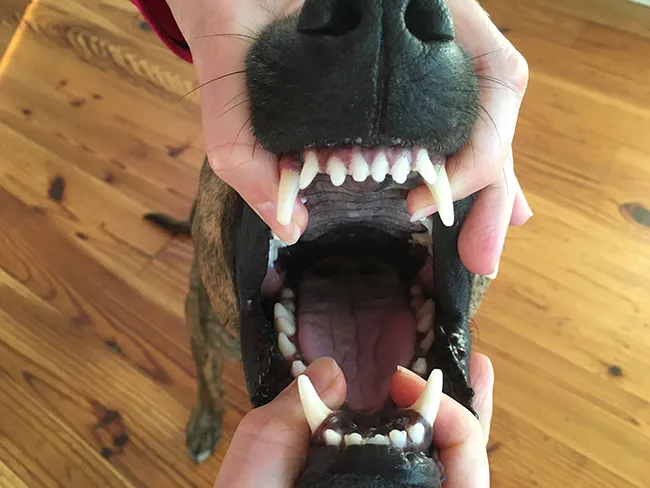As a veterinarian and a pet parent myself, I understand the common frustration when your beloved canine companion refuses to take their medication. Prescribing the right medicine is often just the beginning of the challenge. The real test comes when you, armed with a pill, face your dog, both wondering who will emerge victorious in this silent standoff. The good news is, with the right approach, you can! This guide shares five of my most trusted tips, tricks, and techniques for successfully giving your dog a pill, ensuring they get the vital treatment they need without the stress.
1. The Bribe: For the Food-Motivated Dog Who Won’t Take Pills
If your dog is highly food-motivated, this method is often the simplest and most effective way to administer medication. The key is to completely disguise the pill within a tempting treat. Here are some of my top recommendations for hiding pills:
- Marshmallows: These are a personal favorite for hiding pills, especially mini-marshmallows for smaller dogs. They are inexpensive, low in calories, and I don’t typically worry about them causing pancreatitis.
- A Dab of Peanut Butter: Peanut butter is a popular choice, but it’s crucial to check the ingredient list for xylitol, which is highly toxic to dogs. Chunky peanut butter works best as its texture helps conceal the pill.
- Plain Yogurt or Plain Greek Yogurt: While effective, be mindful that some dogs may experience gastrointestinal upset from lactose. Additionally, avoid giving antibiotics with calcium-rich foods like yogurt, as it can reduce their effectiveness.
- Cooked, Boneless Chicken Breast or Sliced Turkey: Avoid deli meats due to their high sodium content. A small cube or slice is usually sufficient.
- Liverwurst: This is a very rich treat, so a tiny amount is all you need to mask the medicine.
- Hot Dog Pieces: Always cut hot dog discs into halves or quarters to prevent choking hazards.
- Greenies Pill Pockets® (or similar products): These ingenious treats feature a cavity designed specifically for pills or capsules. You simply insert the medication and mold the treat around it. While convenient and generally loved by dogs, they are a specialized product and might not always be readily available.
Above All, Do No Harm
When choosing a treat to hide your dog’s medication, it’s vital to consider their overall health. I generally advise against using cheese, cream cheese, or ice cream due to the risk of triggering pancreatitis. Pancreatitis is a painful and serious inflammatory condition of the pancreas often caused by high-fat foods. If your dog is prone to pancreatitis, exercise caution with peanut butter or fatty meats like hot dogs or liverwurst.
Furthermore, dogs with specific health issues, such as kidney disease or heart disease, may require low-sodium options. For dogs on prescription diets due to allergies or other conditions, using a small amount of the canned version of their prescribed food is often the safest choice for hiding pills. Always discuss suitable food options with your veterinarian, as they have the ultimate say in what is safe and appropriate for your dog. For more information on health concerns, you might want to read about loose motion medicine for dogs if your dog experiences digestive upset.
 A person's hand holding a marshmallow, with a dog looking up eagerly, anticipating the treat.
A person's hand holding a marshmallow, with a dog looking up eagerly, anticipating the treat.
2. The Bait and Switch: For the Clever Dog Who Won’t Eat Medicine
For those cunning canines who seem to outsmart “The Bribe,” “The Bait and Switch” method often proves successful. This technique is second nature to many veterinarians who have learned the hard way that success on the first attempt is paramount. Trust me, trying to give a half-dissolved pill after your dog has spit it out is significantly harder than the initial try.
Here’s how to execute this method to get your dog to take a pill:
- Prepare the Pill: Hide the pill securely in a small piece of a chosen treat.
- Wash Your Hands: This step is crucial. Dogs have an incredibly sensitive sense of smell—up to 10,000 times better than humans. Even a faint scent of medication on your hands can alert them.
- Gather More Treats: Have two additional identical treats ready, without any medication. If you’re using hot dog pieces, for example, approach your dog with three pieces.
- The Bait: Offer the first treat (without the pill).
- The Switch: Immediately follow with the second treat (containing the pill).
- The Happy Ending: Conclude with the third treat (without the pill) to reinforce the positive experience.
3. The Trick and Treat: Mind Games for Resistant Pups
Sometimes, we need to elevate our game. If your dog has become wise to “The Bait and Switch” or was never fooled in the first place, employing a bit of psychology can work wonders.
- Maintain Secrecy: Never let your astute dog see you preparing the medication. Place the pill in the treat when your dog is occupied elsewhere. Keep the medication bottle out of sight and hearing range. The element of surprise is your ally!
- Hand Hygiene is Key: Again, wash your hands thoroughly after handling the pills to eliminate any tell-tale medicinal scent.
- The Goal: Make the treat feel like an earned reward, something special and entirely unsuspicious.
- Performance Reward: Ask your dog to perform a trick or two they usually get rewarded for. This puts them in the mindset to expect a treat. Then, offer the spiked treat (ideally using the “Bait and Switch” sequence) as their well-deserved reward.
- Forbidden Temptation: Like humans, dogs are often drawn to the forbidden. Offering their disguised medication from a fork, spoon, or even your own plate (strategically placed on the floor after your meal) can surprisingly increase their willingness to take it.
- Project Confidence: Dogs are incredibly perceptive. If you approach the task with guilt or apprehension, your dog will sense it and become suspicious. Project confidence, joy, and even a playful attitude during the “pilling” process, and your dog will be more likely to cooperate.
For managing certain joint issues, you might find information on dog hip medicine helpful.
 A dog looking at a marshmallow in a person's hand, ready to eat the treat.
A dog looking at a marshmallow in a person's hand, ready to eat the treat.
4. The “Jaws” Method: Direct Administration
Disclaimer: Do not attempt this technique if you are not absolutely confident that your dog will not bite you under any circumstances.
The “Jaws” method is a viable option when food-based methods fail or when the medication explicitly states it should not be given with food. This technique requires swiftness and precision.
Here’s a step-by-step guide:
- Secure the Upper Jaw: Gently but firmly grasp your dog’s upper jaw just behind the canine teeth with your thumb and first two fingers, with your hand resting on the top of their nose.
- Secure the Lower Jaw: Repeat the process for the lower jaw, placing your fingers just behind the lower canine teeth.
- Open the Mouth: Once your fingers are safely in place, gently but firmly open your dog’s jaws two to three inches wide. For dogs with strong jaws, this may require a bit of coaxing.
- Administer the Pill: With your dominant hand, hold the pill between your pointer finger and thumb. Swiftly push the pill down the tongue, depositing it at the very base of the tongue—over the decisive edge, down the hatch.
- Confirm Swallowing: As you withdraw your hand, you should feel your dog swallow. A lip lick is usually a good sign of success.
 A veterinarian's hand gently opening a dog's mouth to administer a pill, demonstrating the "Jaws" method.
A veterinarian's hand gently opening a dog's mouth to administer a pill, demonstrating the "Jaws" method.
Bonus Tips for the “Jaws” Method
The most common mistake with this technique is placing the pill merely on the tongue. Unless the pill is highly palatable, most dogs will simply spit it out. Success hinges on getting the pill as deep into the throat as possible, as quickly as possible.
If you find it challenging to reach the back of the throat with your fingers, a pet piller device can be very helpful. This tool, resembling a syringe with a plunger, allows for more precise and deeper placement of the pill.
Finally, because some medications can potentially damage the esophagus if they sit there, always follow the “Jaws” technique by offering a few treats or syringing a small amount of water into your dog’s mouth. This helps ensure the pill travels all the way down. If your dog suffers from hip pain, explore options for pain medicine for dogs with hip dysplasia.
5. Your Dog Still Won’t Eat Medicine? Enlist an Accomplice – The Pharmacist
If all else fails and your dog continues to refuse pills, don’t give up! While at your veterinary clinic, inquire about getting your dog’s medication compounded and flavored. Specialty pharmacies (different from typical grocery or big-box store pharmacies) can pulverize the medication, mix it with a potent flavoring, and provide it in a liquid form. This liquid can then be given orally via a syringe or mixed directly into your dog’s food.
You even have a say in the flavoring! If your dog adores the smell of bacon, for instance, mention it to your vet. With several flavoring options available, you can significantly increase the odds of success by choosing one that appeals most to your dog. For those looking for pet care products, information on best dog flea treatment without vet prescription or discount flea and tick meds for dogs might also be useful.
Do Not Crush Tablets or Open Capsules Yourself (Unless Directed by a Vet)
While it might be tempting to skip the compounding pharmacy and crush tablets or open capsules to mix with food yourself, I strongly advise against it unless your veterinarian explicitly instructs you to do so.
Compounding pharmacists are trained professionals who understand how to prepare medication in a way that maintains its safety and effectiveness. Crushing pills or opening capsules at home can lead to incorrect dosing (over or under-dosing), reduce the medication’s efficacy, and even expose you to the medication. Therefore, unless your vet gives you explicit approval, always keep tablets and capsules intact when administering them to your dog.
You + Your Dog + Pills = Success
I hope these five comprehensive tips have equipped you with the confidence and tools needed to successfully give your dog their medication. Remember, if you’re still struggling, your veterinarian is always there to help. When your dog receives the medication they need, everyone wins – especially your beloved canine companion.
Do you have a tip on how to get your dog to take a pill?
Please share your experiences and advice in the comments below! We can always learn from each other.
Looking for more practical ways to help your dog live the happiest, healthiest life possible?
With over 25 years of experience helping veterinary clients navigate everything from administering medication to keeping an aging dog’s mind fit, I am dedicated to helping you ensure your dog enjoys the happiest life possible. Please explore these additional resources for more insights:
- Is My Dog Too Old for Anesthesia?
- Dr. Buzby’s Nail Trimming Without Fear: an online, step-by-step video course with reference guides for confident at-home nail trims.
- Why Non-Slip Grips Instead of Traction Socks or Booties
- Are Antlers Good for Dogs To Chew On? Please “CHEWS” No
